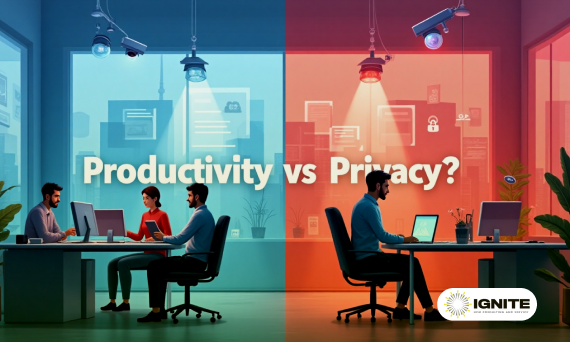
In today's digital age, the line between work and personal life is increasingly blurred. With the rise of remote work and the proliferation of technology in the workplace, employers are facing new challenges when it comes to monitoring employee productivity and protecting company assets. However, this has also raised concerns about employee privacy and the potential for abuse. In this article, we'll explore the complex relationship between productivity and privacy in the workplace and discuss how employers can strike a balance that benefits both the company and its employees.
One of the primary reasons employers monitor their employees is to ensure that they are working efficiently and effectively. By tracking metrics such as time spent on tasks, number of emails sent, and websites visited, employers can identify areas where employees may be struggling or wasting time. This information can then be used to provide targeted training and support to help employees improve their productivity and performance.
Another reason employers monitor their employees is to protect company assets, such as confidential information, intellectual property, and customer data. In today's digital age, data breaches and cyber attacks are becoming increasingly common, and employers have a responsibility to ensure that their employees are handling sensitive information appropriately. By monitoring employee activity, employers can detect and prevent potential security threats before they cause significant damage.
In some industries, such as healthcare and finance, there are strict regulations around data privacy and security. Employers in these industries are required to monitor employee activity to ensure compliance with these regulations and avoid costly fines and legal penalties. Employee monitoring can also help employers detect and prevent illegal activities such as insider trading, fraud, and harassment.

While employee monitoring may have its benefits, it can also erode trust between employers and employees. When employees feel like they are constantly being watched and monitored, they may become less engaged and less motivated to do their best work. This can lead to a toxic work environment where employees feel like they have no autonomy or control over their work.
Constant monitoring can also lead to increased stress and burnout among employees. When employees feel like they can't take a break or step away from their work without being monitored, they may become overwhelmed and exhausted. This can lead to decreased productivity, increased absenteeism, and higher turnover rates.
Perhaps the most significant concern around employee monitoring is the potential for invasion of privacy. While employers may have legitimate reasons for monitoring employee activity, there is a fine line between reasonable monitoring and intrusive surveillance. Employees have a right to privacy, even in the workplace, and employers must be careful not to cross that line.

So how can employers strike a balance between productivity and privacy in the workplace? Here are a few key strategies:
One of the most important things employers can do is to be transparent about their monitoring practices. Employees should be informed about what is being monitored, why it is being monitored, and how the information will be used. This can help build trust and reduce anxiety around monitoring.
Employers should also set clear expectations around employee behavior and productivity. This can include guidelines around appropriate use of company resources, expectations around response times and deadlines, and policies around data privacy and security. By setting clear expectations upfront, employers can avoid misunderstandings and reduce the need for constant monitoring.
Rather than focusing solely on employee activity, employers should also consider outcomes and results. By setting clear goals and objectives and measuring progress towards those goals, employers can ensure that employees are working efficiently and effectively without the need for invasive monitoring.
Finally, employers should provide employees with the support and resources they need to be successful. This can include training and development opportunities, access to mental health resources, and flexible work arrangements. By investing in employee well-being and success, employers can create a positive work environment where monitoring is seen as a tool for growth and development rather than a punitive measure.
The relationship between productivity and privacy in the workplace is a complex one, with valid arguments on both sides. While employee monitoring can help employers ensure that their employees are working efficiently and effectively, it can also erode trust and lead to increased stress and burnout.
Ultimately, the key to striking a balance is transparency, clear expectations, and a focus on outcomes rather than activity. By investing in employee well-being and providing targeted support and resources, employers can create a positive work environment where monitoring is seen as a tool for growth and development rather than a punitive measure.
As the nature of work continues to evolve, it will be important for employers to continually evaluate and adapt their monitoring practices to ensure that they are meeting the needs of both the company and its employees.


